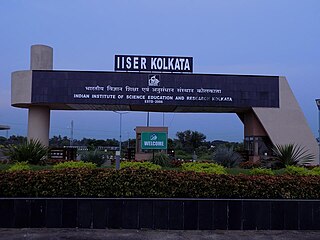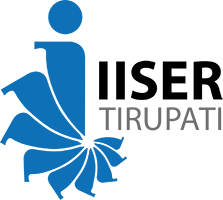Related Research Articles
Joint Entrance Examination – Advanced (JEE-Advanced), is an academic examination held annually in India that tests the skills and knowledge of the applicants in physics, chemistry and maths. It is organised by one of the seven zonal IITs under the guidance of the Joint Admission Board (JAB) on a round-robin rotation pattern for the qualifying candidates of the JEE-Main. It used to be the sole prerequisite for admission to the Indian Institutes of Technology bachelor's programs before the introduction of UCEED, Online B.S. and Olympiad entries, but seats through these new media are very low.

Visvesvaraya Technological University (VTU), is a collegiate public state university in Belagavi, Karnataka established by the Government of Karnataka. It is one of the largest Technological Universities in India with 26 years of Tradition of excellence in Engineering & Technical Education, Research and Innovations. It came into existence in the year 1998 to cater the needs of Indian industries for trained technical manpower with practical experience and sound theoretical knowledge. The university is named after Sir M. Visvesvaraya, an Indian civil engineer, statesman and the 19th Diwan of Mysore.
Joint Management Entrance Test (JMET) was an admission exam used by some institutes in India as the first step in the admission to postgraduate programs in management. Institutes which used the exams included Indian Institute of Science (IISc) and the IIT Schools of Management. The results of JMET were used to short-list the candidates for subsequent part of the selection process. In 2011 JMET was discontinued and replaced by Common Admission Test (CAT).
The Graduate Aptitude Test in Engineering (GATE) is an entrance examination conducted in India that primarily tests the comprehensive understanding of undergraduate subjects in engineering and sciences for admission into postgraduate programs. GATE is conducted jointly by the Indian Institute of Science and seven Indian Institutes of Technologies at Roorkee, Delhi, Guwahati, Kanpur, Kharagpur, Chennai (Madras) and Mumbai (Bombay) on behalf of the National Coordination Board – GATE, Department of Higher Education, Ministry of Education (MoE), Government of India.
The Joint Entrance Examination (JEE) is an engineering entrance assessment conducted for admission to various engineering colleges in India. It comprises two different examinations: the JEE-Main and the JEE-Advanced.

Indian Institutes of Science Education and Research (IISERs) are a group of prestigious autonomous institutions established by the Government of India through the Ministry of Education for teaching and research in natural science and to provide collegiate education in basic sciences integrated with research at the undergraduate level.

Indian Institute of Technology Madras is a public technical university located in Chennai, Tamil Nadu, India. It is one of the eight public Institutes of Eminence of India. As one of the Indian Institutes of Technology (IITs), IIT Madras is also recognized as an Institute of National Importance.

Indian Institute of Science Education and Research, Pune is an autonomous public university established in 2006. It is one of the seven Indian Institutes of Science Education and Research, and was one of the first IISERs to be established along with IISER Kolkata. It is located in the city of Pune, India.

Indian Institute of Science Education and Research, Vithura,Thiruvananthapuram is an autonomous public university located in Vithura, Kerala, India. The institute is one of the seven IISERs established by the Ministry of Human Resource Development, Government of India, to bridge the gap between research and basic sciences' education at the undergraduate level. All IISERs are declared as Institutes of National Importance by the Parliament of India in 2012 through the NIT Amendment Act.

Indian Institute of Science Education and Research, Bhopal is a prestigious autonomous research institute in Bhauri, Bhopal district, Madhya Pradesh, India. It was established by the Ministry of Education (India), Government of India in 2008 in order to incorporate research in fundamental science at undergraduate and graduate level, with equal emphasis on higher education for research and education in science. It is an autonomous institution awarding its own degrees.
The Indian Institutes of Technology (IITs) are a network of engineering and technology institutions in India. Established in 1950, they are under the ownership of the Ministry of Education of the Government of India and are governed by the Institutes of Technology Act, 1961. The Act declares them as Institutes of National Importance and lays down their powers, duties, and framework for governance as the country's premier institutions in the field of technology. The act currently lists twenty-three IITs. Each IIT has autonomy and is linked to others through a common council called the IIT Council, which oversees their administration. The Minister of Education of India is the ex officio chairperson of the IIT Council.

The Joint Admission Test for Masters (JAM) is a common admission test conducted every year for admission into Master of Science (M.Sc.) and other post-graduate science programs at Indian Institutes of Technology (IITs), Indian Institute of Science (IISc), Indian Institutes of Information Technology (IIITs) and National Institutes of Technology (NITs), organized by alternating institutes every year. JAM has been conducted since 2004. The 2021 edition has been organized by Indian Institute of Science. JAM 2022 was Organized by Indian Institute of Technology Roorkee. Indian Institute of Technology Guwahati is the Organizing Institute for JAM 2023. Indian Institute of Technology Madras is the Organizing Institute for JAM 2024.

The Common Entrance Examination for Design (CEED) is a joint entrance exam for post-graduate studies in the field of technological design. The exams are held annually at all Indian Institutes of Technology (IITs) and Indian Institute of Science (IISc). The examination is hosted by the Industrial Design Centre, Indian Institute of Technology Bombay on behalf of Ministry of Human Resource Development, Government of India.
The National Aptitude Test in Architecture (NATA), is conducted by National Institute of Advanced Studies in Architecture (NIASA), which is a body of Council of Architecture, New Delhi in India. The National Aptitude Test in Architecture is a national level examination for admission to undergraduate courses in architecture. The test measures the aptitude of applicants for a specific field of study in areas like drawing and observation skills, sense of proportion, aesthetic sensitivity and critical thinking, qualities that have been acquired over a long period of time and that are related to architecture.
The National Entrance Screening Test is an annual college entrance examination in India, conducted for admission into the National Institute of Science Education and Research, Bhubaneswar (NISER) and the Center for Excellence in Basic Sciences, Mumbai. These two institutes use NEST as a sole criterion for admission to their undergraduate programs.

SWAYAM is an Indian government portal for free open online course (MOOC) platform providing educational courses for university and college learners.

Indian Institute of Science Education and Research, Tirupati commonly referred as IISER Tirupati, is an autonomous public university in Tirupati, Andhra Pradesh, India. It has been established by the Ministry of Human Resource Development, in order to promote Higher Scientific Learning and Research as well as Scientific Exploration at the Undergraduate and Postgraduate levels of education and to create Scientists and Academicians.

National Institutional Ranking Framework (NIRF) is a ranking methodology adopted by the Ministry of Education, Government of India, to rank institutions of higher education in India. The framework was approved by the former Ministry of Human Resource Development and launched by the Minister on 29 September 2015.
The Common University Entrance Test (CUET), earlier known as Central Universities Common Entrance Test (CUCET) is an all-India test being organized by National Testing Agency for admission to various doctorate, Postgraduate, Undergraduate, Integrated Postgraduate, Diploma, Certification courses and Research Programmes in 45 Central Universities of India. It is also accepted by number of other State Universities and Deemed universities in India.
References
- ↑ "Archived copy". Archived from the original on 2023-09-22. Retrieved 2024-01-29.
{{cite web}}: CS1 maint: archived copy as title (link) - ↑ "IISER Aptitude Test (IAT)". Archived from the original on 2023-08-07. Retrieved 2023-08-07.
- ↑ "Eligibility Criteria". Archived from the original on 2023-08-07. Retrieved 2023-08-07.
- ↑ "IISc UG - Information Brochure". Archived from the original on 2023-03-11. Retrieved 2023-11-28.
- ↑ "Archived copy" (PDF). Archived (PDF) from the original on 2023-10-30. Retrieved 2023-11-28.
{{cite web}}: CS1 maint: archived copy as title (link) - ↑ "IISER Aptitude Test (IAT)". IAT 2023. Retrieved 2023-12-03.
- ↑ "Eligibility Criteria". IAT 2024. Retrieved 2024-03-21.
- ↑ "IISER Aptitude Test (IAT)". IAT 2024. Retrieved 2024-03-30.
- ↑ "Syllabus" (PDF). IAT 2024. Retrieved 2024-03-30.